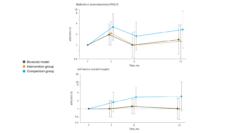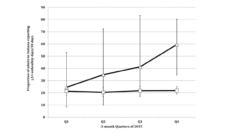In the past, LGBTQ+ adults have faced barriers to getting health care coverage. Before the start of the Affordable Care Act (ACA) expansions in 2014, LGBTQ+ adults were less likely to have Medicaid because they were less likely to have children than non-LGBTQ+ adults. Also, before the legalization of same-sex marriage in 2015, same-sex partners were unable to be covered by employer-sponsored health care plans. As the health insurance landscape has changed, the barriers to health care coverage for LGBTQ+ adults should be decreasing.
Researcher Andrew Bolibol and colleagues analyzed data from the Health Reform Monitoring Survey to compare health insurance coverage and access to and use of care for LGBTQ+ and non-LGBTQ+ adults between 2013 and 2019. The researchers looked at three distinct periods, including the time before the start of the ACA coverage expansions (2013), the early post-ACA period (2014–16), and the late post-ACA period (2017–19). They classified respondents by LGBTQ+ and partner status.
Before ACA insurance expansion, LGBTQ+ adults were less likely to have health insurance and more likely to report difficulty accessing medical care than non-LGBTQ+ adults. The coverage patterns reflect the shift in policy, with increasing coverage for all respondents after the ACA was introduced in 2013. In 2015, there was a general increase in coverage for LGBTQ+ adults, particularly for those who are partnered, as a result of legalizing gay marriage.
By the end of the study period in 2019, insurance coverage had increased for all groups, resulting in no meaningful difference in coverage between partnered LGBTQ+ and non-LGBTQ+ adults. While single LGBTQ+ adults started out with lower coverage rates than the other groups, by 2019 rates had increased, and this group became slightly more likely to have insurance than single, non-LGBTQ+ adults.
Although rates of coverage have generally equalized, disparities in care remain. For instance, the researchers found more LGBTQ+ respondents reported having trouble paying bills and affording necessary medical care, prescription drugs, and mental health services than non-LGBTQ+ respondents. Trying to understand why these health care differences persist remains under study.
Databyte via Andrew Bolibol, Thomas C. Buchmueller, Benjamin Lewis, and Sarah Miller. Health Insurance Coverage And Access To Care Among LGBT Adults, 2013–19. Health Affairs, 2023.














